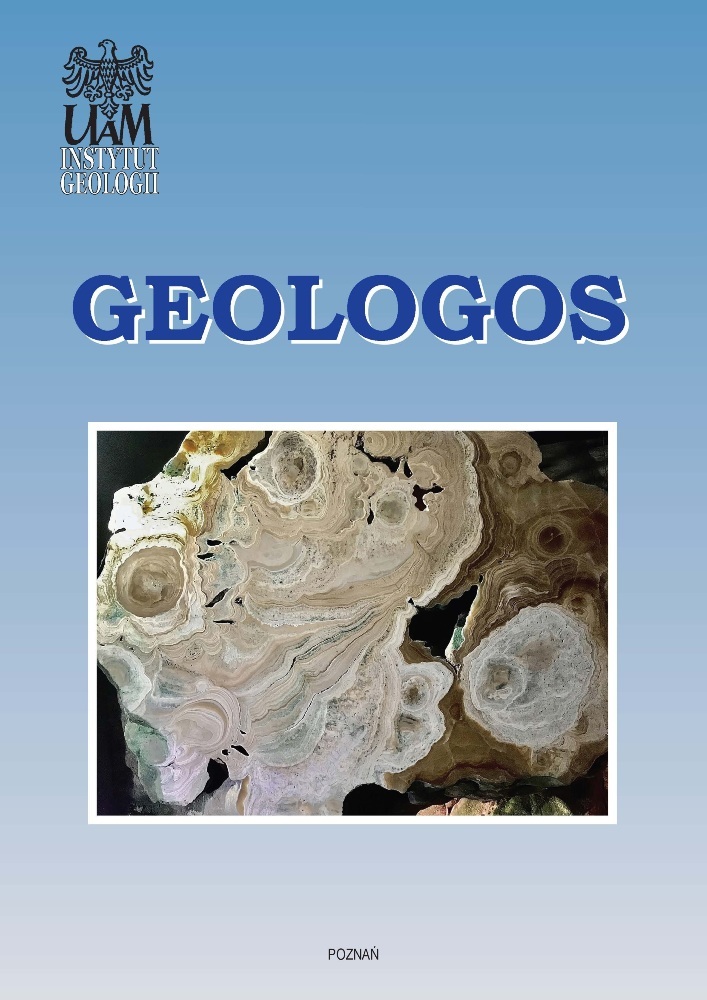Abstract
An exceptional concentration of almost identical depressions exist near the small towns of Krotoszyn, Koźmin and Raszków (southern Wielkopolska). Their origin is, however, different from that of the typical post glacial-relief: they are Man-made enlarged thermal-contraction structures that developed at the very end of the Middle Polish (Warthian) glaciation and during the North Polish (Weichselian) glaciation, most probably under periglacial conditions.
References
Åkerman, J., 1980. Studies on periglacial geomorphology in West Spitsbergen. Proceedings of the Geographical Institute of Lund University 89, 150-227.
Åkerman, J., 1982. Studies on naledi (icing) in Western Spitsbergen. [In:] Hydrology in the Permafrost Regions. Proceedings of the 4th Canadian Permafrost Conference, 189-202.
Bartkowski, T., 1949. Z obserwacji nad "oczkami" Równiny Koźmińskiej [Observations of small symmetrical depressions on the Koźmin Plain]. Sprawozdanie Poznańskiego Towarzystwa Przyjaciół Nauk 2, 299-300.
Bednarek, M., 2003. Litologia obszaru Krotoszyn-Koźmin-Raszków ze szczególnym uwzględnieniem zagłębień bezodpływowych. Okolice miejscowości Łąkociny [Lithology of Krotoszyn-Koźmin-Raszków with special attention for surficial pits. Vicinity of Łękociny]. Institute of Geology, Adam Mickiewicz University, Poznań, 127 pp.
Błaszczyk, J., 1997a. Detailed geological map of Poland 1:50000, sheet Krotoszyn. Polish Geological Institute, Warszawa.
Błaszczyk, J., 1997b. Explanations to detailed geological map of Poland 1:50000, sheet Krotoszyn. Polish Geological Institute, Warszawa.
Bogdański, P. & Kijowski, A., 1990. Photointerpretation of geometry of Vistulian ice-wedge poligons: the Grabinowo and the Sulejewo sites, south of Poznań. Quaestiones Geographicae 11/12, 39-52.
Bukowska-Jania, E., 2003. Rola systemu lodowcowego w obiegu węglanu wapnia w środowisku przyrodniczym (na przykładzie Svalbardu i młodoglacjalnych obszarów Polski północno-zachodniej [The role of glacier systems in the migration of calcium carbonate in the natural environment, with particular reference to Svalbard and the last-glacial areas in NW Poland]. Silesian University Press, Katowice. 247 pp.
French, H. M., 1988. Active layer processes. [In:] M. J. Clark (Ed.): Advances in periglacial geomorphology. J. Wiley and Sons Ltd, Chichester, 151-177.
French, H. M., 2007. The periglacial environment (3rd ed.). J. Wiley and Sons, Chichester, 458 pp.
Kozarski, S., 1995. Deglacjacja północno-zachodniej Polski: warunki środowiska i transformacja geosystemu (~20 ka - 10 ka BP) [The deglaciation of North-Western Poland: environmental conditions and geosystem transformation ~20 ka - 10 ka BP). Dokumentacja Geograficzna (Wrocław) 1, 47-59.
Krygowski, B., 1956. O dwóch nowych podziałach na regiony geograficzne Niziny Wielkopolsko-Kujawskiej [On two new subdivisions of the Great Poland-Kujawy Lowland into geographical regions]. Badania Fizjograficzne nad Polską Zachodnią 3, 75-112.
Krygowski, B., 1961. Geografia fizyczna Niziny Wielkopolskiej, cz. 1 Geomorfologia [Physical geography of the Great Poland Lowland. Part I, Geomorphology]. T. Bartkowski (Ed.). Poznańskie Towarzystwo Przyjaciół Nauk (Poznań), 184-201.
Lopez, B. & Edmaier, B., 2007. Zamrożony pejzaż [Frozen landscape]. National Geographic - Polska 12, 85-99.
Markuszewska, I., 2006. Wpływ zagłębień pomarglowych na kształtowanie krajobrazu rolniczego wybranych fragmentów Wysoczyzny Kaliskiej w ostatnim stuleciu [The influence of marl pits on the agricultural landscape of the Kalisz Plain during the last century]. Bogucki Scientific Press, Poznań, 136 pp.
Nowacki, K., 1999a. Detailed geological map of Poland 1:50000, sheet Raszków. Polish Geological Institute, Warszawa.
Nowacki, K., 1999b. Explanations to detailed geological map of Poland 1:50000, sheet Raszków. Polish Geological Institute, Warszawa. Sikora-Wencławek, K., 2006. Wybrane aspekty litologii osadów czwartorzędowych okolic Krotoszyna [Some aspects of the lithology of the Quaternary sediments in the vicinity of Krotoszyn]. Institute of Geology, Adam Mickiewicz University, Poznań, 87 pp.
Sikora-Wencławek, K., 2006. Wybrane aspekty litologii osadów czwartorzędowych okolic Krotoszyna [Some aspects of the lithology of the Quaternary sediments in the vicinity of Krotoszyn]. Institute of Geology, Adam Mickiewicz University, Poznań, 87 pp.
Stankowski, W., 2001. 14C and TL dating as a metod of establishing the origin of kettle-like hollows. Geochronometria 20, 103-106.
Stankowski, W., 2003. Kosmogeneza i antropogeneza drobnych zagłębień bezodpływowych [The kosmogenic and anthropogenic origin of small depressions]. [In:] A. Kostrzewski (Ed.) Geneza, Litologia, Stratygrafia Utworów Czwartorzędowych 4, Poznań, 85-88.
Witaszak, W., 2003. Litologia obszaru Krotoszyn-Koźmin-Raszków ze szczególnym uwzględnieniem zagłębień bezodpływowych. Okolice miejscowości Ustków [Lithology of the Krotoszyn-Koźmin-Raszków area with special attention for surficial depressions. Vicinity of Ustków]. Institute of Geology, Adam Mickiewicz University, Poznań, 95 pp.
Wysocki, A., 2003. Litologia obszaru Krotoszyn-Koźmin-Raszków ze szczególnym uwzględnieniem zagłębień bezodpływowych. Okolice miejscowości Orpiszew [Lithology of the Krotoszyn-Koźmin-Raszków area with special attention for surficial depressions. Vicinity of Orpiszew]. Institute of Geology, Adam Mickiewicz University, Poznań, 84 pp.
License
This content is open access.
